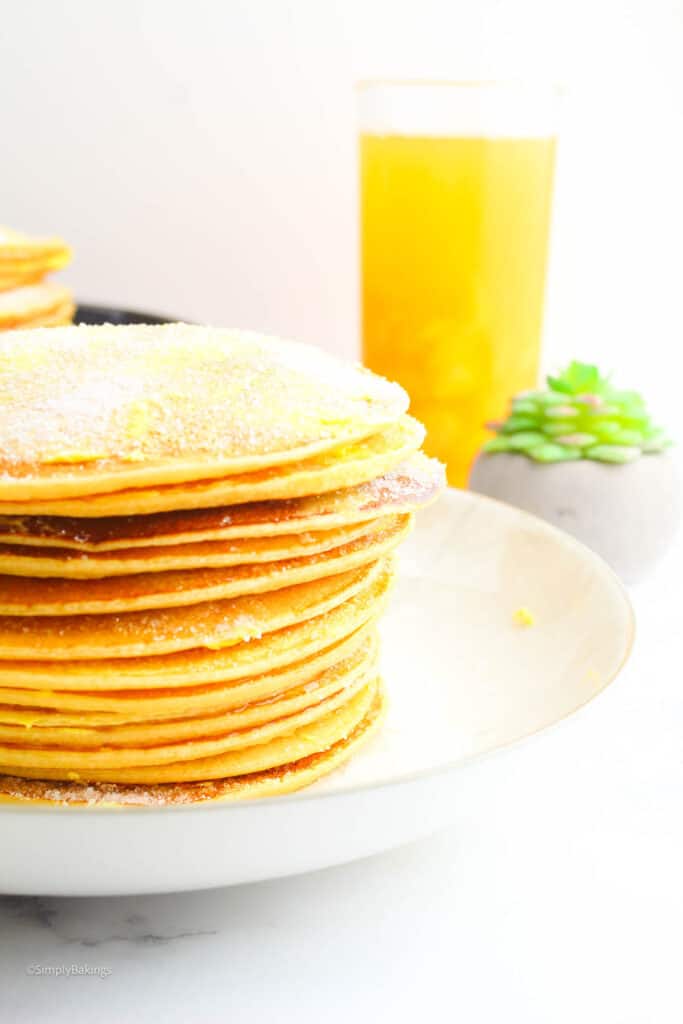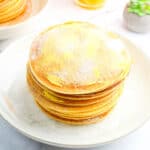Whether it's a leisurely Sunday brunch or a quick weekday treat, these Filipino hot cakes, made of all-purpose flour, brown sugar, and a touch of vanilla magic, are your ticket to a warm and delicious start to any day. Mix, pour, and sizzle these fluffy delights to perfection in just 18 minutes.
On the search for more Pinoy snack recipes? Try my Turon, Bibingka, or my oh-so-good Easy Suman Malagkit.

What are Filipino Hot Cakes?
Filipino Hot Cakes, also called "hotcakes" or "pancakes," are a favorite breakfast in the Philippines. They're fluffy and have a long history in Filipino cooking, influenced by Spanish colonization.
They use brown sugar, a bit of vanilla, and margarine to balance sweetness and richness, reflecting Filipino tastes.
Read more below for its cooking tips and quick and simple step-by-step instructions. Enjoy!
Health Benefits of Pinoy Hot Cakes:
- Quick Energy: Hotcakes provide fast-release carbohydrates for a morning boost.
- Calcium Boost: Full-cream milk supports strong bones and teeth with calcium.
- Protein-Packed: Eggs offer protein and essential vitamins for a balanced meal.
- Gluten-Free Options: Swapping flour allows catering to gluten-free diets.
- Nutritious Toppings: Adding fruits and nuts enhances flavor and nutrition.

Tips and Procedures:
- Substitutions:
- Sugar Variations: Experiment with natural sweeteners like honey or maple syrup instead of granulated white sugar for a different flavor profile.
- Oil Choices: Try different oils, like coconut oil or melted butter, for a unique twist on the hotcake's flavor.
- Egg-Free Option: Replace beaten eggs with mashed bananas for a vegan-friendly alternative.
- Milk Options: You can use evaporated milk if you can’t find full-cream milk or whole milk. Substitute non-dairy milk if you have a dairy allergy.
- Flour Options: Almond flour, wheat flour, and chickpea flour can be substituted if you prefer gluten-free flour.
- Storage:
- Refrigeration: Store leftover hotcakes in an airtight container in the refrigerator for up to three days.
- Freezing: If you anticipate leftovers, freeze cooked hotcakes in a single layer, separated by parchment paper. Thaw and reheat in a toaster or oven for a quick breakfast.
- Preventing Sogginess: To prevent sogginess when reheating, avoid stacking hotcakes while they're still warm.
- Topping Separation: Keep toppings separate during storage to maintain their freshness and texture. Add margarine, sugar, and toppings just before serving.
- On-the-Go: Wrap individual hotcakes in parchment paper for a portable and mess-free breakfast option.

How to Make Filipino Hot Cakes:
Listed below are all the ingredients you will need:
- all-purpose flour
- brown sugar
- baking powder
- salt
- full-cream milk
- large eggs
- vanilla
- vegetable oil
- softened margarine
- granulated white sugar

In a mixing bowl, combine the all-purpose flour, brown sugar, baking powder, and a pinch of salt. This forms the foundation of your hotcake batter.
Pour the full-cream milk, beaten eggs, and vanilla extract into the flour mixture. Use an electric mixer to create a smooth batter. Set aside:

Heat a nonstick pan over medium-low heat with a touch of vegetable oil. Scoop ⅓ cup of batter onto the pan and cook for about 2 minutes, until bubbles form on the surface.
Gently flip the hotcake and cook for an additional minute. Transfer to a serving plate. Repeat with the remaining batter:
As you go, spread softened margarine on each hotcake, followed by a sprinkle of granulated white sugar for a delectable touch of sweetness:
Serve immediately and enjoy!

Frequently Asked Questions:
Preheat the skillet for about 5 minutes on medium-low heat to achieve the perfect pancake consistency.
The main difference between pancakes and hotcakes lies in regional terminology; they generally refer to the same type of dish, both being flat, round, and cooked on a griddle or skillet.
The key lies in the beaten eggs and baking powder. They work together to create those lovely air pockets that make the hotcakes fluffy.
Filipino-Style Hotcake
Ingredients
- 2½ cups all-purpose flour
- ½ cup brown sugar
- 2 teaspoon baking powder
- ¼ teaspoon salt
- 2½ cups full-cream milk
- 2 large eggs beaten
- ¼ teaspoon vanilla
- 2 teaspoons vegetable oil
- ¼ cup granulated white sugar
- ¼ cup softened margarine
Instructions
- Combine flour, brown sugar, baking powder, and salt in a mixing bowl.
- Pour milk, beaten eggs, and vanilla extract into the flour mixture.
- Using an electric mixer, mix until thoroughly combined; set aside.
- Heat the vegetable oil in a nonstick skillet over medium-low heat.
- Scoop and pour ⅓ cup of the hotcake batter into the hot pan.
- Cook on low for 2 minutes or until bubbles are formed on top.
- Flip the hotcake and cook for another minute.
- Remove and transfer to a serving plate.
- Continue with the remaining batter.
- Once all the batter is done, spread the softened margarine into the pancake.
- Sprinkle with granulated white sugar.
- Serve immediately.
Notes
- You can use evaporated milk if you can’t find full-cream milk or whole milk.
- Substitute with non-dairy milk if you have a dairy allergy.
- Almond flour, wheat flour, chickpea flour can be substituted if you prefer gluten-free flour.





Leave a Reply